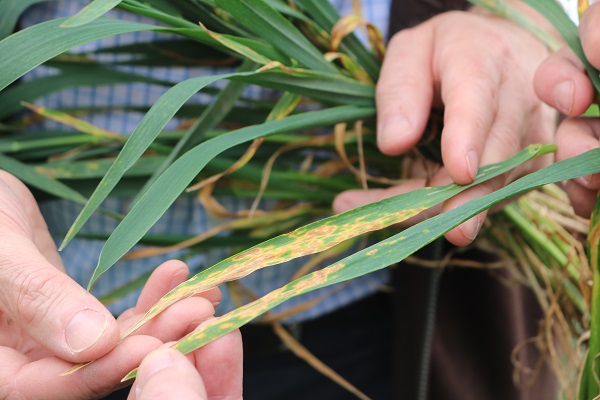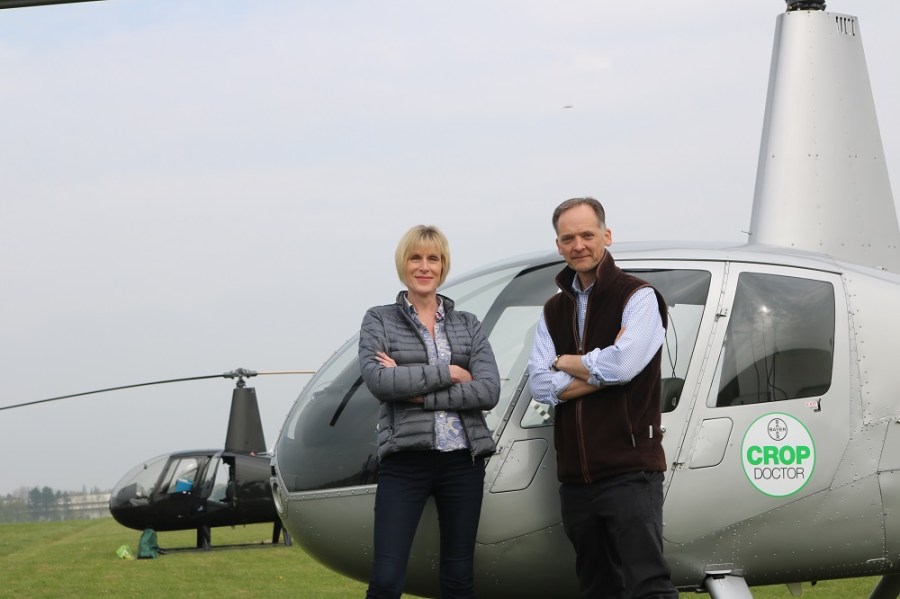Following two visits across UK trials sites with Bayer’s Crop Doctors last season, CPM finds out how observed disease levels shaped up and what these mean for this year’s programmes.
It was a late season in terms of disease which really kicked off with the wet start to June.
By Rob Jones
When the Crop Doctor team took to the skies during March and April last season, disease levels didn’t give any serious concern. Septoria was largely restricted to the base of plants and yellow rust and eyespot were found at varying levels but nothing to cause alarm, according to specialists assessing the trial plots at four locations across the UK.
But it became a season that proved how quickly the disease threat can change, especially septoria. So with assessments and harvest data now received from the four sites, how did the varieties across the UK fare?

Late rain events last year meant septoria levels ‘exploded’ across the four sites visited.
Long Sutton, Lincs
Showers around the middle of May started things moving at the fenland site, hosted at GH Hoyles and Son, and this was then aggravated by downpours in early June –202mm of rain fell in four days at Long Sutton.
The weather washed the potential out of crops says a despondent David Hoyles. “We still had plenty of stems and grains at harvest but specific weights were low – between 71-73 kg/hl. Our yields were 15% down on our five-year average. It looked so promising before the rain.”
Septoria just ‘exploded’ notes Bayer’s Darren Adkins, which was unsurprising given the weather. But just as much of a concern was lodging – a focal point at the Bayer Long Sutton Field Day in July.
Lodging damage was observed in every untreated fungicide plot, despite all receiving a robust three-way PGR programme, he reports. Some treated plots were also affected but not to the same degree.
Darren believes treated plots benefitted from eyespot control. “Prothioconazole has good eyespot activity and plots treated with Aviator (prothioconazole + bixafen) and/or Ascra (prothioconazole + bixafen + fluopyram) benefitted accordingly. Eyespot isn’t a severe yield robber on its own but if it contributes to lodging then the losses soon stack up.”
With the disease widely reported last season, SRUC’s Prof Fiona Burnett believes it was encouraged by another season of mild winter and spring weather resulting in early crop growth. But she also feels management practices are a factor. “Best practice is a two-year break. But rotations are still dominated by cereal crops so it’s rare.”
Callow, Herefordshire
With Herefordshire typically getting close to 150mm more rainfall than Lincs it’s a surprise that Callow avoided the worst of May and June’s downpours. Yet the advance in disease pressure following rainfall events is illustrated here through Bayer research into septoria’s latent phase through measuring DNA levels in leaves.
The research has shown how quickly disease levels climbed with the rain events in May, despite the dry conditions earlier in the season.
ADAS researcher Dr Jonathan Blake says the influence of a dry spell on septoria depends on timing. “Dry weather early in the season has less influence on septoria severity as it does later in the season. Rain splash is the most likely cause of spreading the disease up the canopy but it can continue to cycle with early morning dew.
“That’s what happened last season. Although it had been dry and septoria levels weren’t severe ahead of GS39 there was enough moisture to keep the disease ticking over.”
Given the late season pressure you’d think it was T2 sprays that underpinned 2019 disease control but Jennie thinks last season highlighted the importance of the T1 as much. “Despite low levels of Septoria early on, by the time we were approaching GS43 you could see differences in the upper canopy in our T1 trial plots. There was enough disease in the base of plants to spread up into the canopy with conducive conditions following.”
The talk last spring was of reducing T1 rates and/or switching away from primary septoria actives. Bayer’s Jennie Watson believes that where growers have sown a resilient variety late, there is flexibility at the T1, but sees this as dose rather than switching actives. “Key fungicide timings have to be based on effective septoria actives and the evidence from last season is that prothioconazole, bixafen and fluopyram are clearly still effective,” she notes.
AICC agronomist David Lines feels the T1 application is now on a par with the T2. The loss of curative options means sprays aren’t providing the clean-up they once were. “If leaf 2 becomes infected, septoria has a platform to move up the plant. The T1 is a barrier protecting the upper canopy.”
His typical spend last season was £90/ha, including varieties like Siskin, Graham and Zyatt. He’d rather spend an additional £20/ha and get extra 1-2 t/ha in yield. The spend on Extase wasn’t much less although he feels there is more scope to omit a T0.
Great Tew, Oxon
T0 sprays were in focus when the Crop Doctor team visited Great Tew Estate. Manager Colin Woodward part treated two fields at the T0 timing. With dry weather dominating, differences in the fields of Gravity and Sundance were hard to find at the time.
Drawing definitive conclusions remains, as the dry weather continued and robust T1 sprays followed. But some of the dirtier varieties did carry more septoria later in the season, especially Gravity. “If you’ve got dry weather around GS29 then it is possible to spend less on a T0 with more resilient varieties,” he says.
Whether Colin will do the same this year remains to be seen. That decision probably depends on how yellow rust comes through the winter, he says.
What will remain is a robust T1, however. Despite the drier spring, SDHIs were used at both T1 and T2, and it’s a decision he doesn’t regret. “It was a late season in terms of disease which really kicked off with the wet start to June. Some of the untreated plots in the fungicide trials I host here quickly succumbed.”
Estate winter wheats averaged 10.7 t/ha – a yield Colin was happy with. This is in part due to lodging defence. With the weather, some crops did go over on the run-up to harvest but it wasn’t as bad as he feared. He also feels a robust fungicide programme added to that of an equally robust PGR strategy.
Despite the arrival of new fungicides, he’s also planning to ‘beef up’ cultural measures, starting with variety choice. Last season saw Gleam, Gravity, Sundance, Skyfall, Elicit and Skyscraper sown at Great Tew. But with Colin looking to bolster disease, pests and blackgrass management, Gravity and Skyscraper have been joined by Extase and Firefly.
“It’s their disease profiles that appeal, but also their development – they’ll perform well in a later drilling slot,” notes Colin.
The surprise here may be Gravity, which has a septoria rating of 4.8 on the AHDB Recommended List, but with blackgrass now found on every field he needs varieties that can compete, which is where Skyfall, Elicit and Gleam fall short, he says. “They’re all a little tiller shy and that really stood out last season with the dry spring. Gravity does need a robust disease control programme but its tillering capacity compensated for the conditions. With the septoria resilience of Extase and Firefly we can plan for Gravity being a priority if need be.”
Cawood, Yorks
Protective best practice is the message from Cawood. The site is prone to septoria and yellow rust, and as with the other sites, after a dry spring May rain kicked disease into life, septoria stripping untreated susceptible varieties of green leaf area.
What surprised site manager Sean MacGill was the yield response from the site. Take out highly susceptible varieties like Reflection, which he feels skews the figures, and you’re still left with mean yield responses of over 2.0t/ha. Another surprise was the response to more resilient varieties. “Even Extase delivered economic responses to our four-spray fungicide programme,” he notes.
He feels yellow rust control contributed to site results and the disease was more easily found than in previous seasons. But an increase in yellow rust pressure doesn’t overly concern him. “Whether it’s a shift in the disease or the mild winter I’m not sure but good fungicide programmes held up. Our standard programme starts with a multisite plus tebuconazole at T0 and an azole plus SDHI mix at T1. Those are key timings to control yellow rust.”
Application timing was also a factor. He accepts that maintaining a protective position is easier when treating plots to the realities of commercial farming, something he sees as more important than ever with the loss of CTL. “With any season you are likely to see a period of intense pressure. If that coincides where programme protection is compromised, disease is bound to establish. Kind weather allowed us to hit T1 and T2 application timings and that clearly helped when septoria pressure rose late on.”
Maintaining a protective position will be more challenging with CTL going but he feels it will still be possible – what’s needed is a shift in emphasis. Fungicides have never been a ‘silver bullet’, he says, and for any active to work as designed application timing is key. When azoles had strong curative activity they still worked better as protectants, he points out.
“The fungicide armoury is still strong but we have to minimise the pressure on products. This means an integrated approach to optimise target leaf protection. It calls for improved disease diagnosis via technology like SporeSentry, accurate sprayer set-up and nozzle choice plus using rotation, variety choice, cultivation and drilling date to limit disease establishment,” concludes Sean.
Take to the skies with Crop Doctor
If you would like a bird’s eye view of farming from the air, CPM in conjunction with Bayer is offering a free place on this season’s two Crop Doctor tours.
We’ll be taking to the skies on 30–31 March and 20-21 April to look at trial plots and fields across the country to chat crop progress and disease development. On board will be pathology experts Jonathan Blake and Fiona Burnett, with AICC agronomists and Bayer technical specialists on the ground.
It promises to be an interesting trip and the chance to get an aerial view of UK farming.
To enter all you have to do is send us a picture or video of your best and worst looking fields or crops from this season with a caption, funny, factual or otherwise. The winners will be chosen by the Bayer team.
Please upload your photos and caption via Twitter, Facebook (public post) or Instagram using #cropdoctor or send an email to mike.abram@bayer.com Full terms and conditions are available on the Bayer website.




